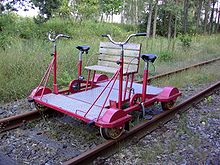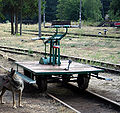- Draisine
-
A draisine primarily refers to a light auxiliary rail vehicle, driven by service personnel, equipped to transport crew and material necessary for the maintenance of railway infrastructure.
The eponymous term is derived from German Baron Karl Christian Ludwig Drais von Sauerbronn, who invented his Laufmaschine (German for "running machine") in 1817, that was called Draisine (German) or Draisienne (French) by the press. It is the first reliable claim for a practically used bicycle, basically the first commercially successful two-wheeled, steerable, human-propelled machine commonly called a velocipede, nicknamed hobby-horse or dandy horse.[1]
Later, the name draisine came to be applied only to versions used on rails and was extended to similar vehicles, even when not human-powered. Because of their low weight and small size, they can be put on and taken off the rails at any place, allowing trains to pass.
In the United States, motor-powered draisines are known as speeders while human-powered ones are referred as handcars.
Contents
Dressin, velorail or railbike
Draisine is spelled dressin in Sweden and dresin in Norway and dræsine in Denmark. In Finland the word is "resiina". Usually, dressin refers to pedal-powered rail-cycles which were used by railroad maintenance workers in Finland, Sweden and Norway until about 1950, as handcars were elsewhere.
Now draisines are used for recreation on several unused railway lines in Germany, Sweden, Norway, Poland and some other European countries. There are several companies renting draisines in Sweden.[2]
In Finland there has been annual competition "Resiina-ralli" (translates "Draisine Rally"), which involves several draisine teams travelling many days on the railways from one corner of the country to another. The rally is televised and is popular with TV-viewers.
Types of draisines
-
Three wheeled draisine at the Saskatchewan Railway Museum
-
Hand-lever draisine handcar
-
Three-wheeled handcar designed to be operated by a single person, widely known in United States as a handcar or velocipede
-
Railcar is another term used for small motorized draisines
-
Motorized draisines are known as speeders and trolleys in the United States
-
Car (Russian GAZ-13 Chaika) converted into a draisine, at the Hungarian Railway Museum
-
Deutsche Bundesbahn draisine based on the Volkswagen Type 2
-
Even this small railbus is related to the draisine
Military usage
The military usage of draisines concerned, first of all, armoured draisines. They were light armoured rail motor vehicles, intended for reconnaissance, scouting, track patrolling and other auxiliary combat tasks, usually belonging to armoured trains. Early vehicles of this kind were built in Russia during World War I. Later, often armoured cars were used as armoured draisines, after exchanging their wheels to railroad ones, or fitting them with additional retractable railroad rollers. Some countries however manufactured purposely built armoured draisines between the wars, like the USSR and Czechoslovakia. Peculiar vehicles were Polish armoured draisines - they were tanks or tankettes fitted with special rail chassis, able to be used on rails or on the ground, leaving the rail chassis on the rails. Some countries developed rail-cum-track armoured draisines, with retractable tracks railroad wheels - they were not widely used, however. Different armoured draisines were used during the Second World War, starting from the invasion of Poland carried out by Nazi Germany.
Construction
By far the most practical railbikes are those that convert a standard bicycle into a vehicle that can be ridden on tracks. This enables the user to leave home and reach the tracks on his bicycle, convert to railbike mode, and then back again to bicycle mode once he has reached his destination. Obviously, the conversion should be fast and straightforward, involving a minimum of steps and a simple, clamp-on mechanism. Furthermore, operation of the device in railbike mode should be stable and dependable. People have been putting bicycles on railroad tracks ever since there have been bicycles and railroads. From time to time, factory-built models have been available, beginning with a device marketed in 1908 through the Sears catalogue, and which cost just $5.45. At the present time, one can purchase plans to convert a regular bicycle into a railbike. Railbikes are a great project for do-it-yourselfers. There are a great many designs out there, without any one design laying claim to absolute superiority. (As with cars and airplanes, each design has its advantages and disadvantages.) But regardless of the design, certain fundamentals must be adhered to. Virtually every design uses a flanged guide roller to keep the bike’s front wheel on the track. In order to do its job this guide roller should support a good portion of the rider’s weight. (Otherwise, the guide roller itself stands a good chance of derailing upon encountering a serious irregularity in the tracks.) In one successful design, the front bike wheel is entirely supported by the guide roller, thus assuring that sufficient weight is pressing down on the roller at all times. The rear bike wheel, while providing traction through direct contact with the rail, must also be guided so as to prevent derailment. In most designs the rear wheel is guided by an outrigger riding on the second rail. This design is satisfactory as long as the two rails are perfectly parallel. But upon encountering stretches where the tracks are no longer parallel – as frequently happens on abandoned tracks – derailments are all too common. This disadvantage can be overcome by the use of additional guide rollers to keep the rear wheel aligned with the track, but with the penalty of added weight. As for the outrigger, it is best to have at least three supporting members in order to provide tripod-like rigidity. The roller on the outrigger is best left flangeless, so as to allow for the loss of parallelism between the two rails. From time to time, someone will suggest dispensing with the outrigger altogether. Why not a one-rail railbike? Although not impossible, such a device would carry a steep penalty in stability, and the rider would be reduced to performing a circus act on a tightrope. Keep in mind that bicycles are kept upright by letting the rider steer in the direction of an impending fall, and that this ability is sacrificed when putting a bicycle on rails.
See also
References
- ^ www.sciencetech.technomuses.ca From Draisienne to Dandyhorse - Retrieved on 2008-06-09
- ^ www.hiddeneurope.co.uk Hidden Europe magazine - articles - muscle power: draisine travel #10, pp. 41-44 - Retrieved on 2006-10-01
External links
Categories:- Human-powered vehicles
- Rail vehicles
- Military railway equipment
-
Wikimedia Foundation. 2010.














